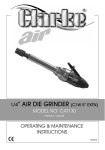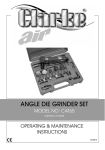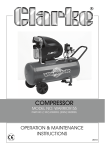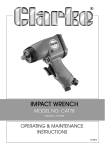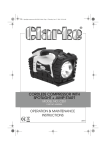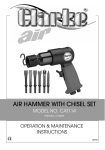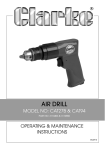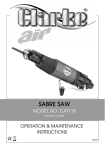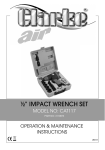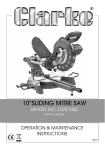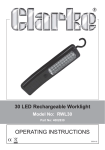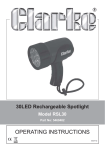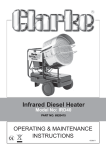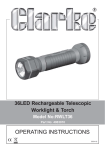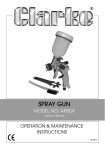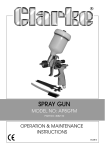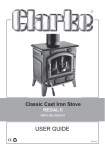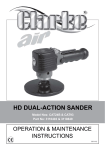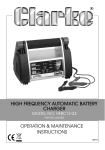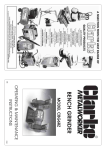Download Clarke CAT121 Instruction manual
Transcript
DUAL ACTION SANDER MODEL NO: CAT121 PART NO: 3110877 OPERATION & MAINTENANCE INSTRUCTIONS LS0211 INTRODUCTION Thank you for purchasing this CLARKE product. Before attempting to use this product, please read this manual thoroughly and follow the instructions carefully. In doing so you will ensure the safety of yourself and that of others around you, and you can look forward to your purchase giving you long and satisfactory service. GUARANTEE This product is guaranteed against faulty manufacture for a period of 12 months from the date of purchase. Please keep your receipt which will be required as proof of purchase. This guarantee is invalid if the product is found to have been abused or tampered with in any way, or not used for the purpose for which it was intended. Faulty goods should be returned to their place of purchase, no product can be returned to us without prior permission. This guarantee does not effect your statutory rights. ENVIRONMENTAL PROTECTION Recycle unwanted materials instead of disposing of them as waste. All tools, accessories and packaging should be sorted, taken to a recycling centre and disposed of in a manner which is compatible with the environment. CONTENTS 1 x Dual Action Orbital Air Sander; 1 x 150mm Backing Pad; 1 x Air Connector 1 x Oil Bottle 1 x Instruction manual 2 Parts & Service: 020 8988 7400 / E-mail: [email protected] or [email protected] TABLE OF CONTENTS INTRODUCTION ......................................................................... 2 GUARANTEE ............................................................................... 2 ENVIRONMENTAL PROTECTION ................................................ 2 CONTENTS ................................................................................. 2 TABLE OF CONTENTS ................................................................. 3 GENERAL SAFETY RULES ............................................................ 4 AIR SUPPLY ................................................................................. 6 Recommended Air Supply Connection ...................................................... 6 THE DUAL ACTION SANDER ...................................................... 7 Before Use ........................................................................................................ 8 Fitting The backing pad ................................................................................. 8 Fitting The Sanding Sheet ............................................................................... 8 Adjusting The Speed ....................................................................................... 9 Using The Sander ............................................................................................. 9 AFTER USE .................................................................................. 10 Disconnecting The Air Supply ........................................................................ 10 Storage ............................................................................................................. 10 MAINTENANCE .......................................................................... 11 SPECIFICATIONS ....................................................................... 12 VIBRATION EMISSIONS ............................................................. 13 DECLARATION OF CONFORMITY ............................................. 15 3 Parts & Service: 020 8988 7400 / E-mail: [email protected] or [email protected] GENERAL SAFETY RULES CAUTION: FAILURE TO FOLLOW THESE PRECAUTIONS COULD RESULT IN PERSONAL INJURY, AND/OR DAMAGE TO PROPERTY. WORK ENVIRONMENT 1. Keep the work area clean and tidy. 2. Dress appropriately - Do not wear loose clothing or jewellery. Tie long hair out of the way. 3. Keep children and visitors away - Do not let children handle the tool. 4. Do not operate the tool where there are flammable liquids or gases. 5. Keep the air supply hose away from heat, oil and sharp edges. 6. Do not fit the tool to any stand or clamping device that may damage the tool. USE 1. Stay alert and use common sense - Do not operate the tool when you are tired or under the influence of alcohol, drugs or medication. 2. Always wear eye protectors when using the tool - Eye protectors must provide protection from flying particles from the front and the side. 3. Always wear ear protectors when using the tool. 4. Do not overreach - Keep proper footing and balance at all times. 5. Never use any type of bottled gas as a source of power for the tool. 6. Do not connect the air supply hose with your finger on the trigger of the tool. 7. Do not exceed the maximum pressure for the tool: 90 psi / 6.2 bar. 8. Check hoses for leaks or worn condition before use, and ensure that all connections are secure. 9. Do not use the tool for any other purpose than that described in this book. 10. Do not carry out any alterations or modifications to the tool. 11. Always disconnect from the air supply when: • Performing any maintenance • The tool is not in use. 4 Parts & Service: 020 8988 7400 / E-mail: [email protected] or [email protected] • The tool will be left unattended. • Moving to another work area. • Passing the tool to another person. 12. Never use the tool if it is defective or operating abnormally. 13. The tool should be serviced at regular intervals by qualified service personnel. 14. Avoid damaging the tool for example by applying excessive force of any kind. 15. ALWAYS maintain the tool with care. Keep it clean for best and safest performance. 16. Quick change couplings should not be located at the tool. They add weight and could fail due to vibration. 17. DO NOT force or misuse the tool. It will do a better and safer job at the rate for which it was designed. 18. Do not remove any labels. Damaged labels should be replaced. 19. This tool vibrates with use. Vibration may be harmful to your hands or arms. Stop using the tool if discomfort, a tingling feeling or pain occurs. Seek medical advice before resuming use. TRANSPORTATION 1. Never carry the tool by the air supply hose. 2. Never carry the tool with your finger on the trigger. STORAGE 1. When not in use the tool must be disconnected from the air supply and stored in a dry place out of the reach of children (preferably in a locked cabinet). 2. Avoid storing the tool in environments where the temperature is below 0oC. 5 Parts & Service: 020 8988 7400 / E-mail: [email protected] or [email protected] AIR SUPPLY WARNING: COMPRESSED AIR CAN BE DANGEROUS. ENSURE THAT YOU ARE FAMILIAR WITH ALL PRECAUTIONS RELATING TO THE USE OF COMPRESSORS AND COMPRESSED AIR SUPPLY. • Use only clean, dry, regulated compressed air as a power source for the tool. • Air compressors used with the tool must comply with the appropriate European Community safety directives. • A build up of moisture or oil in the air compressor will accelerate wear and corrosion in the tool. • Never exceed the maximum operating pressure for the tool. AIR HOSE • The air hose must be rated at least 150% of the maximum operating pressure of the tool. RECOMMENDED AIR SUPPLY CONNECTION 6 Parts & Service: 020 8988 7400 / E-mail: [email protected] or [email protected] THE DUAL ACTION SANDER 1 6 2 3 4 5 NO DESCRIPTION PART NUBER NO DESCRIPTION PART NUBER 1 Trigger RONCAT12101 4 Locking Nut RONCAT12104 2 Speed Control RONCAT12102 5 Backing Pad RONCAT12105 3 Balancer RONCAT12103 6 1/4” BSP (Female Air Inlet) RONCAT12106 7 Parts & Service: 020 8988 7400 / E-mail: [email protected] or [email protected] BEFORE USE WARNING: COMPRESSED AIR CAN BE DANGEROUS. ENSURE THAT YOU ARE FAMILIAR WITH ALL PRECAUTIONS RELATING TO THE USE OF COMPRESSORS AND COMPRESSED AIR SUPPLY. NOTE: Ensure the compressor is turned off. 1. Remove the travel plug from the air inlet at the bottom of the tool. 2. Pour 2-3 drops of CLARKE airline oil into the air inlet. This should be done regardless of whether or not a lubricated air supply is to be used. 3. Connect a suitable hose to the tool as shown. • Use the adapter supplied if required. 4. Connect the other end of the hose to the compressor. You can fit a whip hose with a quick fit coupling if required (available from your Clarke dealer.) FITTING THE BACKING PAD 1. Turn spindle lock until the knurled portion contacts the flat surface on the Spindle. 2. Thread the backing pad into the spindle, by grasping the balancer, with one hand and the pad with the other. Do not over tighten. 3. Now turn the spindle lock so that the knurled portion is away from the flat on the spindle, and the spindle turns freely. 4. DO NOT operate tool with spindle in locked mode as performance would be severely affected, and a hazardous situation may result. FITTING THE SANDING SHEET 1. Peel off the back of the self adhesive sanding sheet and stick it to the backing pad. 8 Parts & Service: 020 8988 7400 / E-mail: [email protected] or [email protected] OPERATION ADJUSTING THE SPEED Adjust the operating speed if required, by twisting the speed control. • Clockwise to increase the sanding speed. • Anticlockwise to decrease the sanding speed. USING THE SANDER 1. Place the sander on the workpiece and press down on the trigger to start the sander. 2. Release pressure from the trigger to stop the sander. 3. Always ensure the sander has stopped before putting it down on any surface after use. NOTE: Replacement sanding sheets are available from your Clarke dealer. 9 Parts & Service: 020 8988 7400 / E-mail: [email protected] or [email protected] AFTER USE DISCONNECTING THE AIR SUPPLY Do not disconnect the air supply hose until the compressor has been shut down and the compressed air released. 1. Refer to the compressor instruction book for the procedures to shut down and release the compressed air. 2. Once the pressure has been released, disconnect the air supply hose from the tool. 3. Store the tool safely in its box in a dry, secure environment. STORAGE • If the tool is to be stored, or is idle for longer than 24 hours, run a few drops of Clarke air line oil into the air inlet, and run the tool for 5 seconds in order to lubricate the internal parts. • When not in use, disconnect from air supply, clean tool and store in a safe, dry place. 10 Parts & Service: 020 8988 7400 / E-mail: [email protected] or [email protected] MAINTENANCE WARNING: MAKE SURE THAT THE TOOL IS DISCONNECTED FROM THE AIR SUPPLY BEFORE STARTING ANY CLEANING, OR MAINTENANCE PROCEDURES. DAILY • Drain water from air tank, air line and compressor. • Pour a few drops of CLARKE Air Line Oil, into the air inlet. This should be carried out regardless of whether or not an inline mini oiler is used. If an inline mini oiler is not used, this procedure should be repeated after every two to three hours of use. NOTE: **Clarke Air Line Oil (part no. 3050825) is available from your CLARKE dealer. WEEKLY • Remove the grub screw from the oil port on the side of the impact wrench and insert a few drops of oil. CLEANING • Keep the body of the tool clean and free from debris, grit or gum deposits in the tool which may reduce efficiency. SERVICE AND REPAIR All servicing and repair must be carried out by qualified service technicians. NOTE: Please note that factors other than the tool may effect its operation and efficiency such as reduced compressor output, excessive drain on the airline, moisture or restrictions in the line, or the use of connectors of improper size or poor condition which will reduce air supply. 11 Parts & Service: 020 8988 7400 / E-mail: [email protected] or [email protected] SPECIFICATIONS Air Consumption 2-16 cfm (56 - 452 l/min) Operating Pressure 90 psi (6.2 bar) Air Inlet Size 1/4 inch BSP Pad Size 150 mm Maximum Speed 10000 rpm Sound Pressure Level (LpA dB) 87.2 dB(A) Guaranteed Sound Power (LwA dB) 98.2 dB(A) Vibration Levels 2.5 m/s2 at the Main Handle K = 1.25 m/s2 Dimensions (L x W x H) mm 223 x 73 x 123 Weight 1.81 Kg Please note that the details and specifications contained herein, are correct at the time of going to print. However CLARKE International reserve the right to change specifications at any time without prior notice. Always consult the machine’s data plate 12 Parts & Service: 020 8988 7400 / E-mail: [email protected] or [email protected] VIBRATION EMISSIONS Employers are advised to refer to the HSE publication “Guide for Employers”. All hand held power tools vibrate to some extent, and this vibration is transmitted to the operator via the handle, or hand used to steady the tool. Vibration from about 2 to 1500 hertz is potentially damaging and is most hazardous in the range from about 5 to 20 hertz. Operators who are regularly exposed to vibration may suffer from Hand Arm Vibration Syndrome (HAVS), which includes ‘dead hand’, ‘dead finger’, and ‘white finger’. These are painful conditions and are widespread in industries where vibrating tools are used. The health risk depends upon the vibration level and the length of time of exposure to it……in effect, a daily vibration dose. Tools are tested using specialised equipment, to approximate the vibration level generated under normal, acceptable operating conditions for the tool in question. For example, a grinder used at 45° on mild steel plate, or a sander on soft wood in a horizontal plane etc. These tests produce a value ‘a’, expressed in metres per second per second, which represents the average vibration level of all tests taken, in three axes where necessary, and a second figure ‘K’, which represents the uncertainty factor, i.e. a value in excess of ‘a’, to which the tool could vibrate under normal conditions. These values appear in “Specifications” on page 12. ‘a’ values in excess of 2.5 m/s2 are considered hazardous when used for prolonged periods. A tool with a vibration value of 2.8 m/s2 may be used for up to 8 hours (cumulative) per day, whereas a tool with a value of 11.2 m/s2 may be used for ½ hour per day only. The graph on the right shows the vibration value against the maximum time the respective tool may be used, per day. The uncertainty factor should also be taken into account when assessing a risk. The two figures ‘a’ and ‘K’ may be added together and the resultant value used to assess the risk. It should be noted that if a tool is used under abnormal, or unusual conditions, then the vibration level could possibly increase significantly. Users must always take this into account and make their own risk assessment, using the graph above as a reference. 13 Parts & Service: 020 8988 7400 / E-mail: [email protected] or [email protected] Some tools with a high vibration value, such as impact wrenches, are generally used for a few seconds at a time, therefore the cumulative time may only be in the order of a few minutes per day. Nevertheless, the cumulative effect, particularly when added to that of other hand held power tools that may be used, must always be taken into account when the total daily dose rate is determined. 14 Parts & Service: 020 8988 7400 / E-mail: [email protected] or [email protected] DECLARATION OF CONFORMITY 15 Parts & Service: 020 8988 7400 / E-mail: [email protected] or [email protected]
















